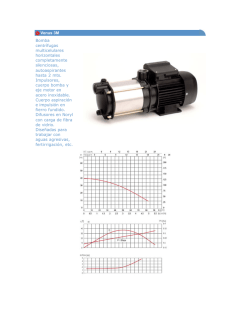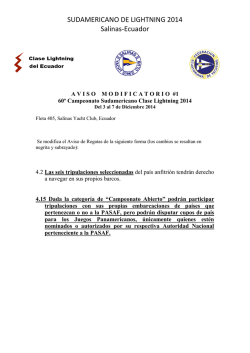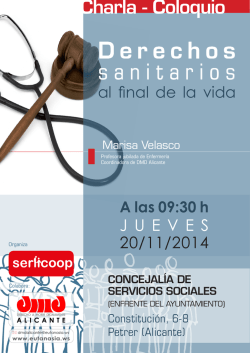
A. Cardesin
ESAC: Centro Europeo de Astronomía Espacial Introducción Grupo de Sistema Solar Alejandro Cardesín Moinelo Operaciones Científicas Mars Express, ExoMars 2016, JUICE Alicante, Junio 2015 ESAC Centro Europeo de Astronomía Espacial Sede de la Agencia Espacial Europea en España desde 2006 en Villanueva de la Cañada, a 30km de Madrid Centro de operaciones científicas para misiones de Astronomía y Sistema Solar. Responsable de operaciones, procesado y archivos de datos Incluye el centro de operaciones de SMOS y el Laboratorio de Astrofísica y Física Fundamental (CAB/INTA) Cerca de 350 personas en total (50~70 dedicadas a Sistema Solar) Centros de Operaciones Científicas (SOC) en ESAC Coordinación de actividades científicas de misiones y experimentos en vuelo – UPLINK : Construcción y validación del plan de observaciones para comandar el satélite – DOWNLINK : Generación y archivado de los datos científicos de cada instrumento INAF Roma ... Obs. Paris DLR Berlin IRF Kiruna Centro de Operaciones Científicas Centro de Operaciones de Misión ESAC ESOC Archivos de Datos Científicos en ESAC – El Planetary Science Archive (PSA) contiene los datos de misiones planetarias de la ESA: Giotto, Huygens, Mars Express, Venus Express, Rosetta y SMART-1. En el futuro también ExoMars, Bepi, JUICE, … http://www.sciops.esa.int/PSA – El ESA Science Data Center (ESDC) incluye también los datos de SOHO, Solar Orbiter y todas las misiones de Astronomía y Astrofísica Centro de Información Geométrica: SPICE en ESAC ESAC Centro Europeo Responsable de SPICE : – Sistema de información geométrica para misiones planetarias: ESA, NASA, JAXA… – Información de objetos del sistema solar, efemérides, etc – Librerías de cálculo de coordenadas, velocidades, ángulos, modelos 3D, … – Soporte de misiones, organización de workshops y programas de formación Investigación Científica en ESAC – Las tareas principales en ESAC son las operaciones y el procesado de datos: – La investigación no es la tarea principal de ESAC, sin embargo: – – Hay posibilidad de dedicar tiempo a ciencia (10-20% best effort basis) – Acceso directo a los datos y contacto directo con los PIs Gran interés por establecer contactos y colaboraciones Posibilidades de Colaboración Científica con ESAC – ESAC Faculty proporciona soporte para actividades de investigación: – Fondos de Investigación para proyectos internos o en colaboración – Convenios oficiales de colaboración en ESAC: – – Programas de estudiantes y jovenes: – Student Trainee (3~6 meses) – Young Graduate Trainee (1 año) – German/Portuguese/Spanish trainees (1~2 años) Programa de post-doc : – Research Fellowship (2 años + 1) Lightning on Venus Searching for optical evidence with VIRTIS on Venus Express Alejandro Cardesín Moinelo, ESAC S. Abildgaard, Aarhus University A. García Muñoz, ESA-ESTEC G. Piccioni, IAPS-Rome D. Grassi, IAPS-Rome Encuentro de Ciencias Planetarias y Sistema Solar, Junio 2015, Alicante CCPPES 2015 Alicante Lightning in the Solar System Lightning detected on Earth, Jupiter, Saturn, Uranus, Neptune Practically, observed on most planetary atmospheres… We should expect it to occur on Venus, right? CCPPES 2015 Alicante Previous searches for lightning on Venus • Electromagnetic evidence: – – – – – Venera 11-14 landers Pioneer Venus Orbiter Galileo Cassini flybys VEX magnetometer Generated by the craft? Generated by plasma perturbations? Too remote observation? NO detection Clear evidence but still some controversy • Optical evidence: – – – – Venera 9-10 noisy/random signal (inconclusive?) PVO Star Tracker NO detection Ground based observations: Hansell et al. 1995 Ground based observations: A. Garcia Muñoz at Calar Alto & La Palma 2011 The existence of lightning on Venus remains controversial! Lightning on Venus What can we expect? • Lightnings on Earth have the strongest emission lines at 777.3nm and 844.6nm, corresponding to atomic oxygen • Laboratory measurements at higher pressures predict that the dominant line at 777.3nm should be present on Venus However: lightning events are expected inside or below the cloud layer (<60km). May be hidden! CCPPES 2015 Alicante Simulated spectrum Lightning on Venus at 5 bars Borucki et al, ICARUS 1996 Lightning on Venus What can we expect? • Transient Luminous Events (TLEs): Sprites, Halos, Elves, are likely to appear at higher altitudes (50~90km) • Dominant emission around 280-420nm, peak at 337nm, (2nd positive band of N2) No presence of oxygen emissions CCPPES 2015 Alicante Dubrovin et al, JGR 2010 Venus Express Contribution • Huge data set (7 years of observations) • Full atmosphere coverage (all latitudes, longitudes, local times, …) • Multi-spectral information (UV, Visible and Near Infrared) • ”Enough” sensitivity (theoretically able to capture flashes) • We can make the most comprehensive search so far! CCPPES 2015 Alicante VIRTIS - Visible Infra-Red Thermal Imaging Spectrometer • VIRTIS-M: Mapping channel • Visible 0.25-1µm • Infrared 1-5µm • 256 x 432 bands (δλ 1~10nm) – 2 spatial dimensions (VIRTIS-M) – 1 spectral dimension • Scientific Objectives – Global study of the atmosphere – Thermal mapping of the surface – Cloud Dynamics, Composition,... Not designed for lightnings L CCPPES 2015 Alicante 256 lines • 3-Dimensional data cubes 256 samp les Lightning & Transient Events on VIRTIS data • Frame/Line scanner: not designed for lightning search. • Transient events cause signal variation in a single frame/line • Effects can be filtered out by calibration, need to analyze raw data • Both Infrared and Visible data with same geometry • Visible signal from nigthside atmosphere is almost negligible • We then use Visible Nightside Long Exposure Nadir Images IR VIS IR VIS CCPPES 2015 Alicante Analysis of the VIRTIS Archive Visible Images in the Nightside Algorithm: • Search for spectral peaks in one single line/frame. • Nightside Raw Visible data • No assumption on emission bands (all wavelengths are considered). A lot of transient events are detected! But we also detect other things. How can we know if we have found lightning? Statistical analysis needed! Analysis of the VIRTIS Archive Visible Images in the Nightside Search for a dominant peak wavelength: • • • • • • • • • Various filters Various emission signal threshold Various emission band widths Only geographical poles Only very long exposures Only terminator Only limbs Only long nadirs Low distance images Main Conclusion No statistical evidence of lightning over several years of VIRTIS data Implications – Lightning could be hidden under cloud layer Contradicts optical observations of lightning on Venus – Lightning has too low energy to be detected by VIRTIS Contradicts Venus Express Magnetometer observations that found the energy of the EM-signals to be close to terrestrial values – Lightning occurrence is rare Also contradicts Venus Express Magnetometer result that predict lightning to be at least same rate as on Earth – Lightning happens only in dayside But there is no theoretical prediction for this – However, this would be interesting! – Or… no lightning on Venus? Hopefully the Akatsuki mission will bring more light to the subject. THANKS QUESTIONS? ESA CCPPES 2015 Alicante Lightning on Venus Optical Evidence? • • • • Venera 9-10 PVO Star Tracker broad band photometry Ground based observations: Hansell et al. 1995 A. Garcia Muñoz at Calar Alto & La Palma CCPPES 2015 Alicante Venus Atmosphere CCPPES 2015 Alicante Venus Express • Launch 09 November 2005 04:43 UTC – Venus Orbit Insertion 11th April 2006 • Polar elliptical orbit – Pericentre ~250 km – Apocentre ~66.000 km – Period ~24 hours • Scientific Objectives – – – – • Atmosphere composition Cloud morphology and structure Atmosphere/surface interaction Thermal mapping (and vulcanism) Instrumentation – – – – – – VIRTIS (Imaging Spectrometer IR-VIS) PFS (IR Spectrometer) SPICAV (UV Spectrometer) VMC (VIS-UV Camera) ASPERA (Plasma science) MAG (Magnetometer) CCPPES 2015 Alicante Venus Atmosphere CCPPES 2015 Alicante Data Calibration pipeline - Summary PDS RAW data cubes VI0044_01.QUB Initialization Pre Processing Radio metric Spectral Post Processing Calibration Pipeline - Dark Frame removal - Bad/Saturated pixels - Thermal correction - Bad frame recovery IEEE Proceedings: WHISPERS Conference 2009 IEEE Transactions: Special Issue on Hyperspectral Image Processing 2009 - Spectral Registration - Radiometric Calibration - Despiking - Destriping Rad (b, s, l ) IR = DN (b, s, l ) IR t IR ⋅ R(b, s ) IR VI0044_01.CAL CCPPES 2015 Alicante VIRTIS details CCPPES 2015 Alicante
© Copyright 2025



